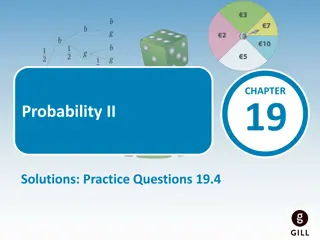Understanding Venn Diagrams and Categorical Syllogisms
Venn diagrams, introduced by John Venn, visually represent relationships between different classes. Shading in diagrams signifies empty sets or no overlap between classes. Different types of categorical statements such as universal and particular are illustrated using examples. Explore how Venn diagrams help in analyzing logical relationships in set theory, probability, and more.
Download Presentation

Please find below an Image/Link to download the presentation.
The content on the website is provided AS IS for your information and personal use only. It may not be sold, licensed, or shared on other websites without obtaining consent from the author. Download presentation by click this link. If you encounter any issues during the download, it is possible that the publisher has removed the file from their server.
E N D
Presentation Transcript
Venn Diagrams and Categorical Syllogisms Unit 5
John Venn 1834 1923 English logician and philosopher noted for introducing the Venn diagram Used in set theory, probability, logic, statistics, and computer science
Shading means the class or set of items is empty there are none that fit that description:
All are, every vs. No are, none, nothing
Representing subjects and predicates visually:
All S are P. Universal Categorical Statement All members of the subject class are also members of the predicate class. All sharks are predators. (The circle on the left represents sharks, the circle on the left is predators.) All apples are sweet. We ve shaded out the area where the non-predator sharks would have been, and where the non-sweet apples would have been. This is known as an A statement.
No S are P. Universal Categorical Statement No members of the subject class are also members of the predicate class. No salmon are porpoises. We shaded the area where a salmon-porpoise would have been, because there cannot be anything existing in that area. This is known as an E statement.
Some S are P. Particular Categorical Statement Some members of the subject class are also members of the predicate class. Some sailors are privates. The X is placed where the sailors who are also privates would exist. This is known as the I statement.
Some S are not P. Particular Categorical Statement Some members of the subject class are not members of the predicate class. Some scholars are not philosophers. This is known as the O form statement.
A, E, I, O There are four basic categorical statement types, named A, E, I, and O. The quantity of a categorical proposition is either universal, or particular. The quality of a categorical proposition is either affirmative, or negative.
A, E, I, O and their quantity and quality A is the universal affirmative statement. E is the universal negative statement. I is the particular affirmative statement. O is the particular negative statement.
The meaning of some In categorical logic some means at least one , which is considered its minimal meaning. Some is the standard form particular quantifier. So, for example, the I statement, Some buses used by the city are roadworthy machines , would mean there s at least one bus used by the city (but not necessarily any more than that one) that is a roadworthy machine.
The Square of Opposition: How the four types of categorical statements relate to each other
Practice: Which diagram goes with each of the following categorical propositions? Give the letter type, and draw the Venn diagram. 1. No Catholics are Protestants. 2. Some cats are Persians. 3. Some dogs are not hunters. 4. All Georgians are Americans. 5. No fish are bipeds.
Categorical Syllogisms Made up of three statements, giving three specific classes of things and how they relate http://philosophy.hku.hk/think/venn/tute3.ph p The webpage above is interactive, and shows how the three statements can be placed on a Venn Diagram made of three circles.
Imagine how to shade in: All men are mortal. Socrates is a man. Therefore, Socrates is mortal.
Socrates is a Man And check to see if there is a space where Socrates can be mortal as well there is, where the X appears below: This is considered valid because the Venn diagram shows that the conclusion is necessarily true: there is no space left for a Socrates who is non- mortal!
Checking what is true on a Venn diagram:
Checking what is true on a Venn diagram:
Venn Diagram checker http://philosophy.hku.hk/think/venn/venn- program.php Use this link to double check how you represent statements on Venn diagrams The page immediately after it explains how to use ticks on a Venn diagram to check Categorical Syllogism arguments for validity
Mood (cont.) Example: All dictators are tyrants. All czars are dictators. Therefore, all czars are tyrants. The mood of this example is AAA.
A Question For You Selecting from the list below, what is the mood of this syllogism? No candidates are witnesses. Some lawyers are witnesses. So, some lawyers are not candidates. A. OIE B. IOE C. EIO D. AOI
Answer Selecting from the list below, what is the mood of this syllogism? No candidates are witnesses. Some lawyers are witnesses. So, some lawyers are not candidates. A. OIE B. IOE C. EIO (Correct) D. AOI
Figure The figure of a syllogism is determined by the position of the middle term. Example: All dictators are tyrants. All czars are dictators. Therefore, all czars are tyrants. In this example the middle term is dictators .
Substituting the letters for the terms (M) dictators- (P) tyrants (S) czars- (M) dictators (S) czars- (P) tyrants This gives us: M P S M S P S refers to the subject term of the conclusion. P refers to the predicate term of the conclusion. M is the middle term, it only appears in the premises.
The 4 Figures: M P P M M P P M S M S M S P S P S P S P M S M S 1STfigure 2NDfigure 3rd figure 4th figure
Figures represented as a bow tie and collar on the M (middle terms) Figure: 1 2 3 4























